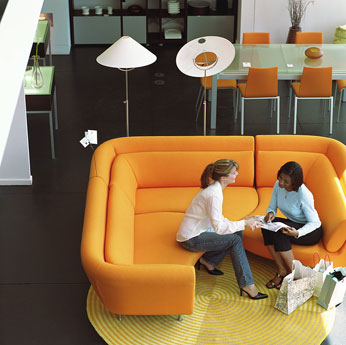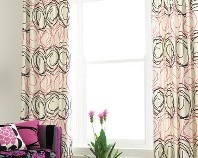On the Business of Decorating
 October 21, 2007
October 21, 2007 Irwin Weiner – I’m often asked if I have difficult clients in my interior design business. I don’t hesitate for a second. The answer: absolutely yes! About 90% of them are difficult . . . and they have every right to be.
 The fact is, if my clients weren’t so picky, they’d shop at Bloomingdales and leave me alone. Of course nice, supportive, and trusting clients are the absolute -- and mostly unattainable -- goal. It’s odd to think that most of my clientele consider themselves to be nice and supportive clients, although that is far from reality.
The fact is, if my clients weren’t so picky, they’d shop at Bloomingdales and leave me alone. Of course nice, supportive, and trusting clients are the absolute -- and mostly unattainable -- goal. It’s odd to think that most of my clientele consider themselves to be nice and supportive clients, although that is far from reality.
But more about that some other time! Now is the time to muse about the design business.
As an experienced and educated professional, I am able to provide a service much like an expensive restaurant. A good interior designer delivers a high-end combination of product and service. Interestingly enough, I’m finding that the high-end service part is more desired than the high-end products themselves.
Online shopping, including websites like Gumps, eBay, and 1stDibs, are clear and easy ways for everyone to shop for merchandise. The Internet is the all-time leveler between decorating professionals and their clients. There’s a certain security in purchasing an item from a respected Internet site; the prices are so easily compared for similar merchandise. Almost gone are the days where one purchased a piece of furniture at an exorbitant price, only to find it in a different store for a fraction of the cost.
With a bit of quick research, true market value is much easier to determine for both design professionals and research-driven clients. Most picky clients like to do their own research to back up what their designers recommend, of course. They want to verify what their designers recommend, sometimes getting valued second opinions from family, friends, and perfect strangers. (Don't get me started on how this tends to drive designers a crazy!)
So high-end products are not necessarily what clients are looking for designers to provide. Service is the in-demand commodity. Busy schedules and fierce competition are what makes good service expensive and hard to come by.
Good design service needs
- to be delivered patiently,
- by an experienced and well-educated professional,
- in a person-to-person, high-touch relationship,
- at fair market rates.
Interior designers are like doctors when it comes to business. First observation: it’s funny how the word facelift is both medical and decorative! Second observation: we both try to see as many patients as we can per hour.
Both doctors and interior designers want to increase productivity and revenue. Truth be told, I also want to own a fabulous home and be wealthy enough to hire a designer! I will try, like any good design professional, to maximize my billable hours. Emails, telephone consultations, and job-site meetings are all very time consuming. And we know that Time = Money, either in or pocket or flying out of our bank account.
So, design clients everywhere, do not be shocked when your decorator always tries to steer you away from unproductive chat time, personal gossip sessions, or friendly soirees. We're professionals, and our meters are running during office hours. In that respect, we're just like any other professional, billing you for our service.
What Abe Lincoln said about lawyers also applied to interior designers: "A decorator's time and advice is his stock in trade."
Here's another business rumination. What amazes me most of all about New York magazine’s annual “Top Doctors” list is the different categories. The areas of specialty represented are vast, and the categories continue to expand. Clearly the wealth of knowledge that’s available has necessitated the need for medical specialists in every form. In looking for a doctor, we want the most educated and experienced service provider in the field.
This applies to interior designers, too. As a residential designer, I’m not very good at designing offices, and I would be even worse at designing a restaurant. That’s the most basic reference, but here are some more subtle reasons for choosing a particular designer over another:
- Match of personality
- Personal taste
- Sense of style
- Great portfolio
- Marquee clients (from the rich and famous to your trusted auntie)
- Age
About that last point: a trendy, young couple is unlikely to hire a much older designer, and many older designers are reluctant to take on whippersnappers.
Let’s carry the comparison of the interior design business to other industries. If a chic restaurant has servers who give me bad attitude, I can walk out. If I have a bad attitude in such a setting, the restaurant is unlikely to tell me to leave. One has the power to scream at an airlines representative for not giving out an upgrade, and it's your basic understanding that the airline is not going to blacklist you.
This represents an essential difference in the interior design industry versus other high-end luxury service industries. When it comes to the interior design industry, firing happens both ways. I have fired clients for the following reasons, and I am proud for doing so and standing my ground as a professional:
- Second-guessing my designs
- Seeing me as someone to expedite their designs rather than seeing me as the design source
- Not committing to purchases
Interestingly enough, I have not fired anyone (yet) for being rude or abusive. Designers tend to take a lot of boorish behavior in stride as part of the territory of working with clients on sensitive, difficult, emotional projects. Ones home, after all, is most personal, and it's traumatic to see it ripped up and put back together again by relative strangers.
Here's an aspect of the design business that I find fascinating. See what you make of it . . . . I have been told by many shelter magazine editors and design publicists that the best work from interior designers is their own homes. The budgets might not be as large as their clients, but the creativity and freshness is there in spades, without compromise.
So what do these rumblings all amount to? I think they have helped form my Design Business Manifesto: I am worth everything I earn from my design clients. My two decades of interior design experience, added to my seven years of formal design training, and my fifteen years of managing my own design firm have helped me refine my skills and define the type and style of design I do best. As a design professional, I give great service, I am a business professional, and I can help a client achieve a beautiful interior.
I and my fellow decorators perform their jobs well and relate daily to their clients’ needs. Our clients should develop a trust in the professional design process, and trust their chosen interior designer to do a great job on their behalf. This, coupled with a good working relationship, is all one needs to get a great interior.
The decorating process should be fun, creative, and enjoyable for both professional and client. Designers are professionals who treat their creativity always from a business perspective. We stay in business because we're discerning and professional.
As noted earlier, when a client doesn't allow us to do our business professionally, they're sometimes fired.
For tips and advice on hiring design professionals, watch our Professional Help video.
Photo Credit: All Art Schools















